Butterflies and moths are insects in the order Lepidoptera. Virtually all butterfly and moth species—including all the ones in the Yuba-Sutter area—eat plants exclusively. More than half of all herbivorous insect species in the United States are butterflies and moths, and the caterpillars of these various species are consequently a primary food source for most bird species in the United States.1
All butterflies in the gossamer-wing family are all rather small, while those in the swallowtail family are large and have a tail-like extension on each hindwing. Butterflies in the brushfoot family are generally of intermediate size. Butterflies in the skipper family are small and spread their hindwings when they land, while keeping their forewings relatively vertical.
As entomologist Douglas W. Tallamy explains in his book Bringing Nature Home: How You Can Sustain Wildlife with Native Plants:
|
People often ask what differentiates moths from butterflies. Several generalities can be made, but most are fraught with exceptions. Most moths are nocturnal, while all butterflies are diurnal (active by day). Moths are typically fatter and the scales on their wings rub off on your fingers quite easily. Butterflies, in contrast, are more streamlined in body and their wing scales are affixed more securely. Moth antennae are feathery (pectinate) or are narrow filaments without a terminal knob. Butterfly antenna always have a knob at the end that is recurved back like a small hook. Finally, moths usually hold their wings flat over their abdomen[s] when resting, while butterflies hold the wings upright and pressed tightly together. Skippers seem to be a compromise between moths and butterflies. Their most distinguishing trait is that they hold their two wings at different angles when at rest; the hind wing is spread wider than the forewing. |
In the same book, Tallamy also explains that most insect species, including butterflies and moths, are only able to eat one or two plant species during their larval stage—native plant species that the insects have evolved alongside for milennia—and that these native plant species are increasingly endangered as areas of former wilderness are increasingly converted to suburbs or overrun by invasive weeds. As the native plant species become endangered, the butterflies that eat them also become endangered, and so do the birds that eat the butterflies. Unfortunately, many people who want to attract butterflies to their yard plant only non-native species such as "butterfly bush" that adult butterflies collect pollen from, but that caterpillars cannot eat. This does nothing to stop the eventual extinction of the butterflies. Tallamy explains what you can do to make a real difference:
|
Let's use the monarch butterfly as an example. Monarchs are in trouble for many reasons. For one thing, millions are hit by cars while en route to their Mexican wintering sites each fall. The most serious threat, though, is that the forests in which they spend the winter in the mountains of Mexico are being illegally logged. Thinning the forest buffer increases weather-related mortality in wintering monarch populations each year. Until the political will to protect the monarch's forests materializes, the only hope for this species is to make sure that those butterflies that do survive the winter reproduce successfully—and hugely—when they return to your backyards each summer. |
|
A civic association could help local monarchs in several ways. First, members of the association could be encouraged to include milkweeds in private landscapes and public spaces alike. Monarchs, like most herbivores, are limited in their ability to make more monarchs primarily by food availability. The more food provided in the form of milkweed plants, the greater the number of monarchs produced. Next, the association could coordinate the sequential cutting of some milkweed patches in June, and again in July, so that monarch larvae will have tender, young milkweed leaves to eat not only in the early weeks of summer, but in August and early September as well. The civic association might also attempt to convince the township to stop mowing roadsides that support milkweed populations during the summer. A single cutting in mid-October is enough to maintain good road visibility and will avoid the needless destruction of roadside habitat. Restraint in mowing would also save the township money, as well as reduce the production of noise, carcinogens, and climate-changing gases [from lawnmowers]. |
|
Neighborhood children could be mobilized to keep records of monarch popukations over the years. What day does the first monarch return to your neighborhood each year? Whose milkweed garden is producing the most monarch larvae? How many monarchs pass through specified checkpoints in the neighborhood during the fall migration south? The degree to which your neighbrhood interacts with the monarch butterfly is limited only by your imagination. I can think of no better way to reconnect with nature than to adopt a species such as the monarch, or any number of plant and bird species with declining populations. Being part of a group that successfully restores the local population of a species in trouble will not only build camaraderie with your neighbors, but may be one of the most rewarding and fulfilling things you ever do. |
Even if starting a neighborhood association sounds too difficult, you can do most of these same things to help save monarchs from extinction all by yourself. Just plant some milkweed! Or pick any other species of butterflies and moths listed in the charts below, all of which are native to the Yuba-Sutter area,2 and plant the species that their larvae depend on for food.
There is one butterfly species in the Yuba-Sutter area that is not native: the cabbage white butterfly, which is native to Europe but was accidentally imported to California a little over a century ago and has naturalized in both Yuba and Sutter Counties. Because it is a native to Europe, its caterpillars eat primarily the leaves of plants that are native to Europe—including many of our most invasive weeds: mustards, radishes, horseradish, Mediterranean hoary mustard, broadleaf pepperweeds, and garden nasturtium.
There are several moth species in the Yuba-Sutter area that are not native, including the common clothes moth.
Butterflies
Brushfoot Family
|
Species |
Found in |
Caterpillars Eat Leaves of |
Adults Drink Nectar of |
More Info at |
|
Milkweed Butterflies: |
 The monarch (Danaus plexippus) is an example of a milkweed butterfly. Photo by queerbychoice. The monarch (Danaus plexippus) is an example of a milkweed butterfly. Photo by queerbychoice. |
|
monarch |
Yuba and Sutter Counties |
native milkweeds (non-native milkweeds can be bad for them!) |
milkweeds, wild hyacinths, coyote mints, barberries, California licorice mints, desert willows, Venus thistles, coast sunflowers, serpentine sunflowers, bladderpods, blue lobelias, golden currants, black sage, and woolly blue curls |
Art Shapiro's Butterfly Site and Las Pilitas Nursery |
|
Longwings: |
|
Callippe fritillary |
Yuba County |
California golden violet exclusively |
coyote mints, milkweeds, sages,Indianhemp dogbane, and yerba santa |
Art Shapiro's Butterfly site and Las Pilitas Nursery |
|
Coronis fritillary |
Yuba County |
violets |
California buckeyes, Venus thistles,rabbitbrush, goldenrods, and California asters |
Art Shapiro's Butterfly site |
|
Hydaspe fritillary |
Yuba County |
violets |
milkweeds, giant hyssops,Indianhemp dogbane, and yerba santa |
Art Shapiro's Butterfly site |
|
Zerene fritillary |
Yuba County |
violets |
milkweeds, giant hyssops,Venus thistles, rabbitbrush, and alfalfa |
Art Shapiro's Butterfly site |
|
True Brushfoots: |
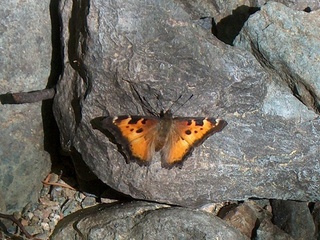 California tortoiseshell (Nymphalis californica), shown near Strawberry Valley, is an example of a true brushfoot. Photo by queerbychoice. California tortoiseshell (Nymphalis californica), shown near Strawberry Valley, is an example of a true brushfoot. Photo by queerbychoice. |
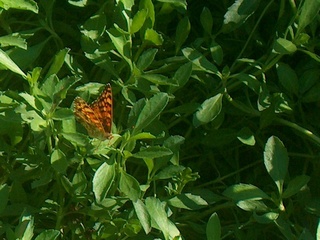 Mylitta crescent (Phyciodes mylitta), shown on turkey-tangle fogfruit in Marysville, is an example of a true brushfoot. Photo by queerbychoice. Mylitta crescent (Phyciodes mylitta), shown on turkey-tangle fogfruit in Marysville, is an example of a true brushfoot. Photo by queerbychoice. |
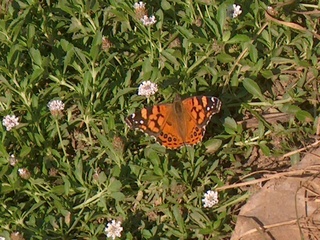 West Coast lady (Vanessa annabella), shown on turkey-tangle fogfruit in Marysville, is an example of a true brushfoot. Photo by queerbychoice. West Coast lady (Vanessa annabella), shown on turkey-tangle fogfruit in Marysville, is an example of a true brushfoot. Photo by queerbychoice. |
|
Milbert's tortoiseshell |
Yuba and Sutter Counties |
|
|
|
|
Leanira checkerspot |
Yuba and Sutter Counties |
paintbrushes |
naked buckwheat, coyote mints, yerba santa, and woolly sunflowers |
Art Shapiro's Butterfly Site |
|
Northern checkerspot |
Yuba and Sutter Counties |
roughleaf asters, rabbitbrush, and goldenrods |
milkweeds, California buckeyes, Indianhemp dogbane, Venus thistles, yerba santa, and woolly sunflowers |
Art Shapiro's Butterfly Site |
|
Chalcedon checkerspot |
Yuba and Sutter Counties |
beardtongues, monkeyflowers, snowberries, rabbitbrush, Venus thistles, Chinese houses, chuparosa, sand asters, turkey-tangle fogfruit, desert asters, California figwort, and desert sunflowers |
coyote mints, daisies, pincushion flowers,California buckeyes, yerba santa, globe gilyflower, California yerba santa, serpentine sunflowers, phacelias, fragrant sumac, and black sage |
Art Shapiro's Butterfly Site and Las Pilitas Nursery |
|
common buckeye |
Yuba and Sutter Counties |
monkeyflowers, snapdragons, turkey-tangle fogfruit, and plantains |
coyote brushes, rabbitbrush, and sages |
Art Shapiro's Butterfly Site and Las Pilitas Nursery |
|
mourning cloak |
Yuba and Sutter Counties |
willows, common hackberries, and elms |
willows and rabbitbrush |
Art Shapiro's Butterfly Site |
|
California tortoiseshell |
Yuba and Sutter Counties |
California lilacs |
manzanitas |
Art Shapiro's Butterfly Site and Las Pilitas Nursery |
|
Mylitta crescent |
Yuba and Sutter Counties |
Venus thistles and non-native plumeless thistles and milk thistles |
thistles, rabbitbrush, yerba santa, and wild heliotrope |
Art Shapiro's Butterfly Site |
|
field crescent |
Yuba and Sutter Counties |
|
|
|
|
green comma |
Yuba County |
willows and Western azalea |
members of the aster family |
Art Shapiro's Butterfly Site |
|
hoary comma |
Yuba County |
currants |
|
Las Pilitas Nursery |
|
satyr comma |
Sutter County |
hoary nettle |
|
Art Shapiro's Butterfly Site |
|
West Coast lady |
Yuba and Sutter Counties |
bush mallows, checker mallows, globe mallows, and stinging nettles |
milkweeds, sages, and turkey-tangle fogfruit |
Art Shapiro's Butterfly Site and Las Pilitas Nursery |
|
red admiral |
Yuba and Sutter Counties |
stinging nettles and other members of the nettle family |
|
Art Shapiro's Butterfly Site and Las Pilitas Nursery |
|
painted lady |
Yuba and Sutter Counties |
Venus thistles, fiddlenecks, cryptanths, cheeseweeds, stinging nettles, and other plants in the aster, borage, and mallow families |
blue lobelias, Caliornia asters, rabbitbrush, and sages |
Art Shapiro's Butterfly Site and Las Pilitas Nursery |
|
American lady |
Yuba and Sutter Counties |
pearly everlastings |
buckwheats, coyote mints, milkweeds, Indianhemp dogbane, coyote brushes, rabbitbrush, sages, and goldenrods |
Art Shapiro's Butterfly Site and Las Pilitas Nursery |
|
Admirals and Relatives: |
|
California sister |
Yuba and Sutter Counties |
oaks, especially the evergreen ones |
native edible fruits, California buckeyes, giant hyssops, Indianhemp dogbane, coyote brushes, yerba santa, and goldenrods |
Art Shapiro's Butterfly Site and Las Pilitas Nursery |
|
Lorquin's admiral |
Yuba and Sutter Counties |
willows, Western chokecherries, and Frémont's cottonwoods |
coyote mints, California buckeyes, buttonbushes, and California yerba santa |
Art Shapiro's Butterfly Site and Las Pilitas Nursery |
|
Satyrs and Wood-Nymphs: |
|
Great Basin wood nymph |
Yuba County |
buckwheats and members of the aster family |
|
Art Shapiro's Butterfly Site |
|
common ringlet |
Yuba and Sutter Counties |
perennial grasses |
|
Art Shapiro's Butterfly Site |
Gossamer-Wing Family
|
Species |
Found in |
Caterpillars Eat Leaves of |
Adults Drink Nectar of |
More Info at |
|
Coppers: |
|
lustrous copper |
Yuba County |
sheep sorrel and alpine sorrel |
clovers, pussypaws, pepperweeds, and members of the aster family |
Art Shapiro's Butterfly Site |
|
gorgon copper |
Yuba County |
naked buckwheats |
naked buckwheats, milkweeds, Indianhemp dogbane, and woolly sunflowers |
Art Shapiro's Butterfly Site |
|
purplish copper |
Yuba and Sutter Counties |
knotweeds, cinquefoils, and docks |
coyote brushes, wild heliotrope, alfalfa, turkey-tangle fogfruit, and California asters |
Art Shapiro's Butterfly Site |
|
blue copper |
Yuba County |
buckwheats |
|
Art Shapiro's Butterfly Site |
|
great copper |
Sutter County |
curly dock |
Indianhemp dogbane, gum plants, wild heliotrope, pepperweeds, common horehound, and members of the carrot family |
Art Shapiro's Butterfly Site |
|
Hairstreaks: |
 Gray hairstreak (Strymon melinus), shown on a California aster in a Marysville garden, is an example of a hairstreak. Photo by queerbychoice. Gray hairstreak (Strymon melinus), shown on a California aster in a Marysville garden, is an example of a hairstreak. Photo by queerbychoice. |
|
great purple hairstreak |
Yuba and Sutter Counties |
bigleaf mistletoe, Eastern mistletoe, and Pacific mistletoe |
milkweeds, California buckeyes, Indianhemp dogbane, lantanas, pepperweeds, goldenrods, zinnias, and members of the carrot family |
Art Shapiro's Butterfly Site and Las Pilitas Nursery |
|
Western green hairstreak |
Yuba and Sutter Counties |
|
|
|
|
brown elfin |
Yuba and Sutter Counties |
California lilacs, soap lilies, dodder, and madrone |
|
Las Pilitas Nursery |
|
bramble green hairstreak |
Yuba County |
buckwheats, California lilacs, and California broom |
buckwheats, California buckeyes, Indianhemp dogbane, Red Valerian, yerba santa, and woolly sunflowers |
Art Shapiro's Butterfly Site and Las Pilitas Nursery |
|
Western pine elfin |
Yuba County |
|
|
|
|
Muir's hairstreak |
Yuba County |
|
|
|
|
Nelson's hairstreak |
Yuba County |
|
|
|
|
thicket hairstreak |
Yuba County |
|
|
|
|
golden hairstreak |
Yuba County |
canyon live oak and tanbark oak |
|
Art Shapiro's Butterfly Site |
|
gold-hunter's hairstreak |
Yuba and Sutter Counties |
oaks |
naked buckwheat, California buckeyes, Indianhemp dogbane, and yerba santa |
Art Shapiro's Butterfly Site |
|
California hairstreak |
Yuba and Sutter Counties |
California lilacs, oaks, willows, Western chokecherries, Saskatoon serviceberries, tobacco brush, and mountain mahogany |
buckwheats, milkweeds, oaks, California buckeyes, Indianhemp dogbane, common horehound, alfalfa, and sweetclovers |
Art Shapiro's Butterfly Site and Las Pilitas Nursery |
|
hedgerow hairstreak |
Yuba County |
California lilacs |
buckwheats and rabbitbrush |
Art Shapiro's Butterfly Site |
|
Sylvan hairstreak |
Yuba and Sutter Counties |
willows |
milkweeds, naked buckwheat, yarrow, Indianhemp dogbane, and members of the carrot family |
Art Shapiro's Butterfly Site |
|
mountain mahogany hairstreak |
Yuba County |
mountain mahogany |
buckwheats, milkweeds, California buckeyes, yerba santa, alfalfa], yellow Ivesia, alfalfa, white sweetclover |
Art Shapiro's Butterfly Site |
|
gray hairstreak |
Yuba and Sutter Counties |
buckwheats, clovers, deervetches, oaks, pines, coffeeberries, doveweeds, cheeseweeds, alfalfa, and members of the pea and mallow families |
daisies, wild heliotrope and white-flowered members of the carrot family |
Art Shapiro's Butterfly Site and Las Pilitas Nursery |
|
Blues: |
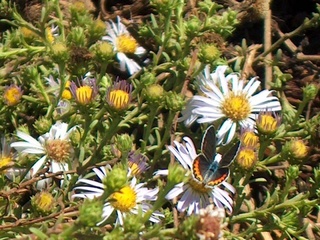 This female Acmon blue (Plebejus acmon), shown on a California aster in a Marysville garden, is an example of a blue. The top side of a male's wings are blue. Photo by queerbychoice. This female Acmon blue (Plebejus acmon), shown on a California aster in a Marysville garden, is an example of a blue. The top side of a male's wings are blue. Photo by queerbychoice. |
|
Western pygmy-blue |
Yuba and Sutter Counties |
spear orache, Australian saltbush, pickleweeds, Russian thistles, Western sea purslane, seablites |
native daisies, coyote brushes, and goldenrods |
Art Shapiro's Butterfly Site |
|
Western tailed-blue |
Yuba County |
|
|
|
|
Eastern tailed-blue |
Yuba and Sutter Counties |
|
|
|
|
Pacific dotted-blue |
Yuba County |
naked buckwheat |
|
Art Shapiro's Butterfly Site |
|
silvery blue |
Yuba and Sutter Counties |
perennial lupines, Lathyrus jepsonii, and vetches |
fiddlenecks |
Art Shapiro's Butterfly Site |
|
arrowhead blue |
Yuba County |
perennial lupines |
buckwheats, Indianhemp dogbane, yerba santa, vetches, and members of the mint family |
Art Shapiro's Butterfly Site |
|
Acmon blue |
Yuba and Sutter Counties |
buckwheats, deervetches, lupines, saltbushes, canyon liveforevers, and knotweeds |
buckwheats, milkweeds, coyote brushes, rabbitbrush, and wild heliotrope |
Art Shapiro's Butterfly Site and Las Pilitas Nursery |
|
Boisduval's blue |
Yuba County |
perennial lupines |
buckwheats, pussypaws, and members of the aster family |
Art Shapiro's Butterfly Site |
|
lupine blue |
Yuba County |
buckwheats |
pussypaws |
Art Shapiro's Butterfly Site |
|
greenish blue |
Yuba County |
native clovers |
clovers |
Art Shapiro's Butterfly Site |
Metalmark Family
Parnassian and Swallowtail Family
|
Species |
Found in |
Caterpillars Eat Leaves of |
Adults Drink Nectar of |
More Info at |
|
Parnassians: |
|
Clodius parnassian |
Yuba County |
Pacific bleeding heart |
coyote mints and yerba santa |
Art Shapiro's Butterfly Site |
|
Swallowtails: |
|
pipevine swallowtail |
Yuba and Sutter Counties |
California pipevine |
blue dicks, Ithuriel's spears, California buckeyes, yerba santa, and radishes |
Art Shapiro's Butterfly Site |
|
pale swallowtail |
Yuba and Sutter Counties |
buckthorns and California lilacs |
coyote mints, blue dicks, Ithuriel's spears, California buckeyes, columbines, yerba santa, Western wallflower, Washington lily, and American vetch |
Art Shapiro's Butterfly Site and Las Pilitas Nursery |
|
Indra swallowtail |
Yuba County |
springparsleys and desertparsleys |
|
Art Shapiro's Butterfly Site |
|
two-tailed swallowtail |
Yuba and Sutter Counties |
Western chokecherries, ashes, Western sycamores, and Western hop trees |
milkweeds, California buckeyes, giant hyssops, yerba santa, and Humboldt's lilies |
Art Shapiro's Butterfly Site |
|
Western tiger swallowtail |
Yuba and Sutter Counties |
willows, Western chokecherries, alders, birches, ashes, privets, sweet gums, Western sycamores, Frémont's cottonwoods, and lilacs |
coyote mints, milkweeds, California buckeyes, Indianhemp dogbane, yerba santa, Humboldt's lilies, blue lobelia, sages, lilacs, and woolly blue curls |
Art Shapiro's Butterfly Site and Las Pilitas Nursery |
|
anise swallowtail |
Yuba and Sutter Counties |
Brewer's angelica, poison hemlock, water hemlock, wild carrots, fennels, desertparsleys, water parsleys, yampahs, and umbrellaworts |
beardtongues, coyote mints, blue dicks, Ithuriel's spears, Western chokecherries, California buckeyes, buttonbushes, Venus thistles, yerba santa, and Western hop trees |
Art Shapiro's Butterfly Site and Las Pilitas Nursery |
Skipper Family
|
Species |
Found in |
Caterpillars Eat Leaves of |
Adults Drink Nectar of |
More Info at |
|
Spread-Wing Skippers: |
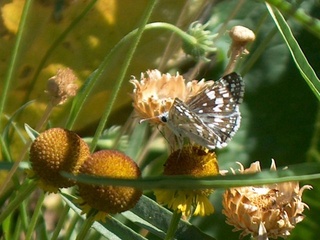 Common checkered-skipper (Pyrgus communis), shown on a rosilla in a Marysville garden, is an example of a spreadwing skipper. Photo by queerbychoice. Common checkered-skipper (Pyrgus communis), shown on a rosilla in a Marysville garden, is an example of a spreadwing skipper. Photo by queerbychoice. |
|
Persius duskywing |
Yuba and Sutter Counties |
deervetches |
|
Art Shapiro's Butterfly Site |
|
Propertius duskywing |
Yuba and Sutter Counties |
oaks |
milkweeds, blue dicks, California buckeyes, fiddlenecks, Indianhemp dogbane, pussypaws, yerba santa, phacelias, and American vetch |
Art Shapiro's Butterfly Site |
|
mournful duskywing |
Yuba and Sutter Counties |
valley oaks |
California buckeyes, yerba santa, and Western vervain |
Art Shapiro's Butterfly Site |
|
Northern white-skipper |
Yuba and Sutter Counties |
bush mallows and globe mallows |
rabbitbrush, yerba santa, blue lobelias, and butterweeds |
Art Shapiro's Butterfly Site and Las Pilitas Nursery |
|
common sootywing |
Yuba and Sutter Counties |
pigweeds |
clovers and turkey-tangle fogfruit |
Art Shapiro's Butterfly Site |
|
common checkered-skipper |
Yuba and Sutter Counties |
Frémont's bush mallow, alkali mallow, checker mallows, globe mallows, and cheeseweeds |
daisies and rosillas |
Art Shapiro's Butterfly Site |
|
small checkered-skipper |
Yuba and Sutter Counties |
alkali mallow |
|
Art Shapiro's Butterfly Site |
|
Northern cloudywing |
Yuba County |
deervetches, leather roots, and peas |
cluster-lilies, California buckeyes, Indianhemp dogbane, yerba santa, and American vetch |
Art Shapiro's Butterfly Site |
|
Grass Skippers: |
 Fiery skipper (Hylephila phyleus), shown on a California aster in a Marysville garden, is an example of a grass skipper. Photo by queerbychoice. Fiery skipper (Hylephila phyleus), shown on a California aster in a Marysville garden, is an example of a grass skipper. Photo by queerbychoice. |
|
common roadside-skipper |
Yuba County |
perennial grasses |
Indianhemp dogbane, American vetch, and members of the mint family |
Art Shapiro's Butterfly Site |
|
sachem |
Yuba and Sutter Counties |
perennial grasses, especially bermuda grass and dallis grasses |
Indianhemp dogbane, coyote brushes, Venus thistles, rabbitbrush, alfalfa, goldenrods, and common verbena |
Art Shapiro's Butterfly Site |
|
Western branded skipper |
Yuba County |
sweet vernal grass |
coyote mints, naked buckwheat, and Indianhemp dogbane |
Art Shapiro's Butterfly Site |
|
Juba skipper |
Yuba County |
perennial grasses |
dandelions, pussypaws, rabbitbrush, and California aster |
Art Shapiro's Butterfly Site |
|
Lindsey's skipper |
Yuba County |
perennial grasses |
clarkias, big scale balsam root and mule ears |
Art Shapiro's Butterfly Site |
|
fiery skipper |
Yuba and Sutter Counties |
perennial grasses, especially bermuda grass and alkali grass |
California aster, lantanas, marigolds, common verbena, and zinnias |
Art Shapiro's Butterfly Site |
|
Eufala skipper |
Yuba and Sutter Counties |
perennial or summer-annual grasses, especially bermuda grass, barnyard grasses, dallis grasses, sorghum, and rice |
wild heliotrope, turkey-tangle fogfruit, and American vetch |
Art Shapiro's Butterfly Site |
|
rural skipper |
Yuba and Sutter Counties |
perennial grasses |
coyote mints, California buckeyes, and yerba santa |
Art Shapiro's Butterfly Site |
|
woodland skipper |
Yuba and Sutter Counties |
perennial grasses |
Indianhemp dogbane, coyote brushes, rabbitbrush, goldenrods, and California aster |
Art Shapiro's Butterfly Site |
|
umber skipper |
Yuba County |
perennial grasses |
milkweeds, California buckeyes, Indianhemp dogbane, coyote brushes, Venus thistles, yerba santa |
Art Shapiro's Butterfly Site |
|
sandhill skipper |
Yuba and Sutter Counties |
alkali grass and occasionally bermuda grass |
rabbitbrush, wild heliotrope, turkey-tangle fogfruit, and California aster |
Art Shapiro's Butterfly Site |
|
Sonora skipper |
Yuba County |
perennial grasses |
pussypaws, goldenrods, and California aster |
Art Shapiro's Butterfly Site |
White and Sulfur Family
|
Species |
Found in |
Caterpillars Eat Leaves of |
Adults Drink Nectar of |
More Info at |
|
Whites: |
|
Pacific orangetip |
Yuba and Sutter Counties |
California toothworts, rock toothworts, wintercresses; mustards, radishes, hedgemustards |
blue dicks, fiddlenecks, California buckeyes, yerba santa, and members of the mustard family |
Art Shapiro's Butterfly Site |
|
large marble |
Yuba and Sutter Counties |
mustards, radishes, flixweeds, California mustards, and hedgemustards |
|
Art Shapiro's Butterfly Site |
|
California marble |
Yuba County |
rockcresses and jewelflowers |
blue dicks, fiddlenecks, phacelias, jewelflowers, Indianhemp dogbane, yerba santa, and members of the aster and mustard families |
Art Shapiro's Butterfly Site |
|
pine white |
Yuba County |
yellow pines and gray pines |
daisies, thistles, goldenrods, and rabbitbrush |
Art Shapiro's Butterfly Site |
|
margined white |
Yuba County |
|
|
|
|
checkered white |
Yuba and Sutter Counties |
mustards, hedgemustards, pepperweeds, Mediterranean hoary mustard, tall tumblemustard, and other usually small, unsucculent members of the mustard family |
daisies, rabbitbrush, alfalfa, and other plants in the aster, mustard, and pea families |
Art Shapiro's Butterfly Site and Las Pilitas Nursery |
|
spring white |
Yuba County |
rockcresses, jewelflowers, and flixweed |
|
Art Shapiro's Butterfly Site |
|
Sulfurs: |
|
orange sulfur |
Yuba and Sutter Counties |
clovers, deervetches, lupines, milkvetches, alfalfa, vetch, and other plants in the pea family |
deervetches, milkweeds, and sand asters |
Art Shapiro's Butterfly Site and Las Pilitas Nursery |
|
California dogface |
Yuba and Sutter Counties |
California false indigo exclusively |
coyote mints, thistles, sages, vervains, California buckeyes, California fuchsias, and woolly blue curls |
Art Shapiro's Butterfly Site and Las Pilitas Nursery |
Moths
Wild Silk Moth Family
Sphinx Moth and Hawkmoth Family
Prominent Family
Tiger Moth and Lichen Moth Family
Owlet Moths and Miller Moth Family
|
Species |
Found in |
Caterpillars Eat Leaves of |
Adults Drink Nectar of |
More Info at |
|
flower moth |
Sutter County |
|
|
|
Oecophorid Moth Family
Links
Butterfly Moth Lepidoptera Butterflies and Moths Art Shapiro's Butterfly Site Las Pilitas Nursery: California Butterflies and California Native Plants
Footnotes
1. Bringing Nature Home: How You Can Sustain Wildlife with Native Plants by Douglas W. Tallamy. Portland: Timber Press, 2007
2. Butterflies and Moths
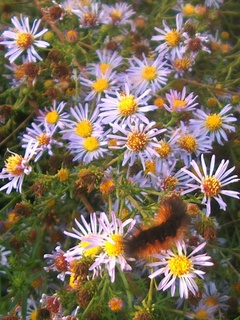 Salt marsh caterpillars (Estigmene acrea) are one of several species of tiger moth caterpillars that are sometimes referred to as "woolly bears" because of their fur, which darkens to black and brown as they age. This one is shown on a California aster in Marysville. Photo by queerbychoice.
Salt marsh caterpillars (Estigmene acrea) are one of several species of tiger moth caterpillars that are sometimes referred to as "woolly bears" because of their fur, which darkens to black and brown as they age. This one is shown on a California aster in Marysville. Photo by queerbychoice.  Sabulella depressariine moth (Agonopterix sabulella), shown on yarrow foliage in a Marysville garden. Photo by queerbychoice.
Sabulella depressariine moth (Agonopterix sabulella), shown on yarrow foliage in a Marysville garden. Photo by queerbychoice. 









